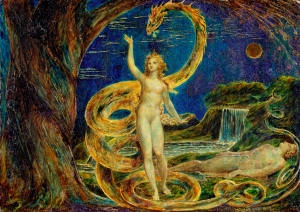The term, Lindorm, is both Danish and Swedish. Depending on its use, it can be synonymous with Lindworm, used in reference to any giant serpent, or used to represent a sea serpent.
I’m sure there’s a plausible answer, but I wonder how cultures from cold, northern climates developed mythologies with huge, reptilian monsters.
There is an interesting folktale called Prince Lindorm (also King Lindorm, Prince Lindworm, and King Lindworm) that has been called Danish, Norwegian, or Swedish. Let’s just say it’s Scandinavian. This tale has generated a bit of modern fan art. It has also been portrayed by professional illustrators. I especially like the older examples. I’m not entirely certain as to who did the following illustration. Owing to its similarity to the next one, I’m inclined to attribute it (tentatively) to Henry Justice Ford, but I could be wrong.
You can find various versions of this tale in their entirety and for free by typing in the title on a word search. I won’t provide links due to their number. One element they all seem to have in common is the one shown above. A prince under a curse exists as a Lindorm and demands a bride. A number don’t make the cut and are messily dismembered. Finally, one tries a different approach. Wearing multiple gowns, she insists first that the snake shed his skin when he orders her to undress. He does so, and she removes one gown. This process is repeated until the Lindorm is an almost shapeless mass. The maiden then scrubs away the offending flesh to reveal a handsome prince.
The theme of serpents and maidens is VERY old and rather widespread in mythology and in folktales. Here is an image which I can attribute to Henry Justice Ford:

I know it’s not the same thing, but I can’t help but notice the similarity of these images to the Genesis account of the serpent tempting Eve in the Garden of Eden (one version of how all the trouble started, but keep in mind that Adam was also described as culpable in that account). This has been represented so many times that I suffered from choice anxiety when choosing images for this post. I opted for variety, including selections from William Blake…

Eve Tempted by the Serpent by William Blake.
… to this interesting, more cartoonish, and different cultural perspective by David-Dennis…
…to this oddly chimeric take by Jon Roddam Spencer Stanhope…

… and a similar but older adaptation by Michelangelo on the ceiling of the Sistine Chapel.

This seems like as good a place as any to stop (or would it be better to say begin?).
p.s. For moral purposes, let me say that Eve is portrayed without clothing in all of these examples because, well… she was.
Next week: something else suitably scaly.



Yikes, brother! You know you’ve made me scared of dark shadows again – but really, am enjoying Nathan Turner (almost done)!
LikeLiked by 1 person
Thank you for reading (and enjoying) this story. I hope you will like the next (and final) installment as well.
LikeLiked by 1 person
Bob, I enjoy these posts too, especially your own drawings.
Your novel’s prose is filled with nuggets of wisdom from experience and observation, and a sense of spiritual truths in symbols. I like the series. :0)
LikeLiked by 1 person
I really appreciate your comment. I was wondering if anyone was reading that story. I have found that it is easy to disappear in cyberspace.
LikeLiked by 1 person
This morning I read the account of The Dissection of juvenile Monster! :0)
Our stories are things we are so invested in, Bob – I understand the wondering.
LikeLiked by 1 person
Thank you, Maria. FYI, that passage is based on my experience at the college. For years we had a lab unit on fetal pig dissection. It’s a very effective way to teach students about their own anatomy, and it afforded me opportunity to interact with them more closely.
LikeLiked by 1 person
That was not a weird folklore at all.😐
By the way nice image you drew again (JK)
LikeLiked by 1 person
Thank you. The folktale was one which I found interesting, and I like finding out about stories I have never read. Take care.
LikeLiked by 1 person
My education into Mythology continues. And then there’s that old saying, ” A snake in the grass.” Thank you once again professor.
LikeLiked by 1 person
You are most welcome. I’m glad you enjoyed this.
LikeLike